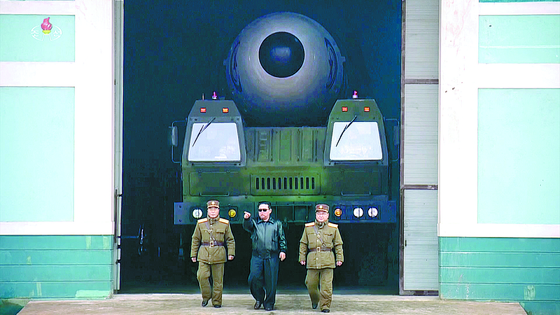The art of cheating the enemy

Chae Byung-gun
The author is the international, diplomatic and security news director of the JoongAng Ilbo.
Considering its past trajectory, North Korea has a pretty consistent tactic for unveiling its new weapons. You can call it “psychological warfare of exaggeration” or “psychological warfare of deception.
In November, North Korea announced that it had launched a military reconnaissance satellite and taken photos of U.S. military bases in Guam and Hawaii. However, the South Korean intelligence community reacted in a lukewarm manner as it could not confirm whether the satellite really had the precise sub-meter resolution or if North Korea could make a tiny adjustment to the satellite’s position in space to focus on a specific target.
In September, the North unveiled its new “tactical nuclear submarine,” but experts were not impressed. A Western analyst called it “a Frankenstein sub” as its hull was abnormally stretched as if pieces were glued together.
Normally, you do not reveal your pivotal capabilities like nuclear subs and military satellites because you can only make a surprise attack by hiding what you have. But North Korea defies common sense. It enjoys revealing its weapons and overstating its capabilities.
Can we just laugh about the North’s decades-long trick? We cannot simply brush it off. The stratagem is basically aimed at deceiving its enemy. After showing off its bizarre-looking submarine and an unproven satellite, North Korea fired an intercontinental ballistic missile (ICBM) on Monday. After a concert of bluffing, it tested the real thing.
In April 2012, the North unveiled a new ICBM during a military parade. After analyzing it through video records, Western experts found fault with its unusual appearance. They claimed North Korea displayed a mock-up ICBM.
In 2016, the country released a photo of a ball-shaped nuclear warhead, which quickly earned the moniker of “disco ball” on Twitter. The image of the warhead really looked like the ball hanging from the ceiling of a banquet hall, brilliantly flashing and glowing. And yet, North Korea has built ICBMs that can reach the U.S. mainland. It already completed a hydrogen bomb test in January 2016.
The past shows the future. The North’s Frankenstein submarine may be a substandard sub that exposes itself by making noise with its diesel engines. But there is no assurance that it will be the same 20 years from now. If we think about what North Korea was like 20 years ago, the country 20 years from now will be even more powerful.
There are two approaches to observing North Korea. One is the political and diplomatic approach of the West. From the perspective of Western rationality, the keywords that define the North are unpredictability, irrationality, human rights abuse and dictatorship.
Exposing nuclear warheads — a strategic weapon that should never be unveiled to the outside — is a classic example of irrational behavior. From the Western perspective, North Korea’s exaggeration reflects the impatience of the leadership, which has failed to create the strong nation it promised to its people.

The other is the immanent perspective. According to the perspective, the North’s third-generation power succession is the only option the country has to sustain the post-Kim Il Sung regime. But the intrinsic perspective sometimes makes more candid revelations of the North’s intention, as illustrated by its uninterrupted exaggeration of its nuclear capabilities.
North Korea has two desperate goals. The first is the completion of its nuclear weapons program, and the second is the United States’s acceptance of its nuclear capabilities. In other words, the North’s goal is to become a nuclear power recognized by the U.S. North Korea consistently demands Washington end hostility toward Pyongyang while reiterating that it is open to both dialogue and confrontation. But the North’s premise of the dialogue is the U.S.’s recognition of the country as a nuclear weapons state, not nuclear dismantlement.
To continue its nuclear development without disruption, North Korea must hide how far it has progressed. But if North Korea wants to be recognized as a nuclear power, it must show the U.S. how far it has come. So, the North is using the psychological warfare of mixing facts and deceptions to blur America’s judgment on the contrasting two goals. By making fuzzy what is false and what is true, the North lures the international community to underestimate its capabilities to buy time to continue its nuclear development program while inflating its nuclear threats to fuel a sense of crisis for the U.S. to eventually win recognition as a nuclear power.
In this sense, North Korea is neither ridiculous nor unpredictable. It has consistently followed the path of getting recognized as a nuclear weapons state while advancing them — through a meticulous mix of deception and truth. Underestimating the North for being anxious and bluffing, you will be caught off guard at some point.










with the Korea JoongAng Daily
To write comments, please log in to one of the accounts.
Standards Board Policy (0/250자)